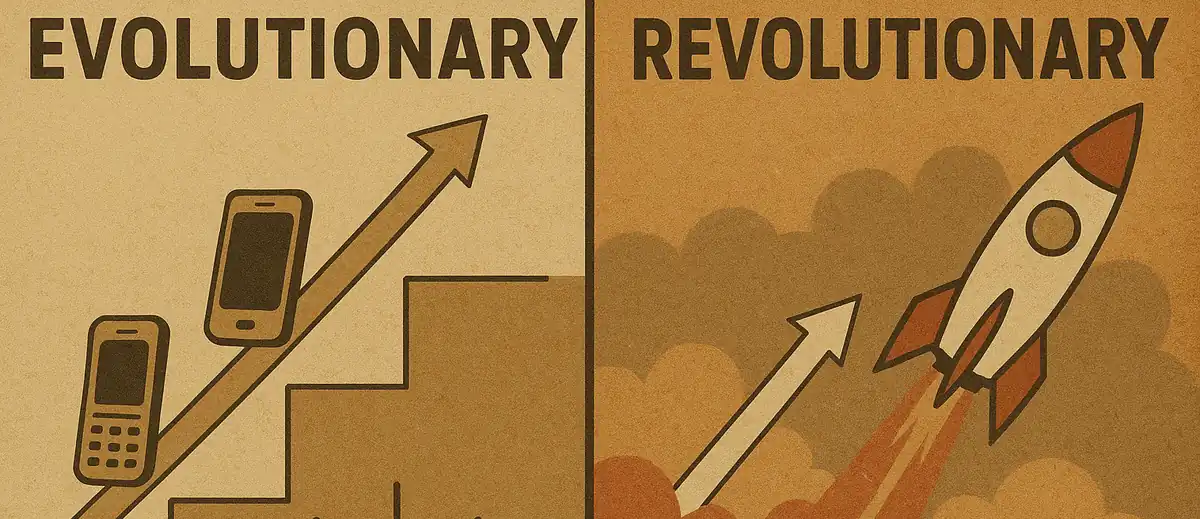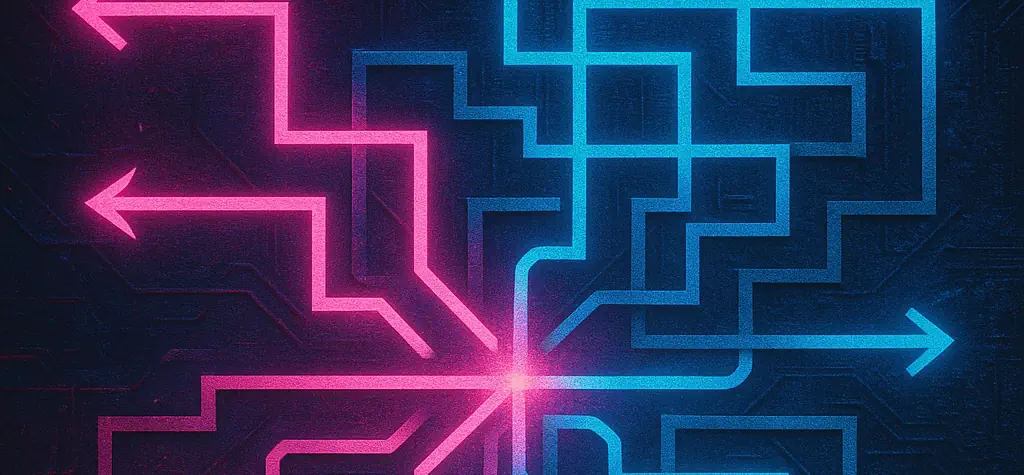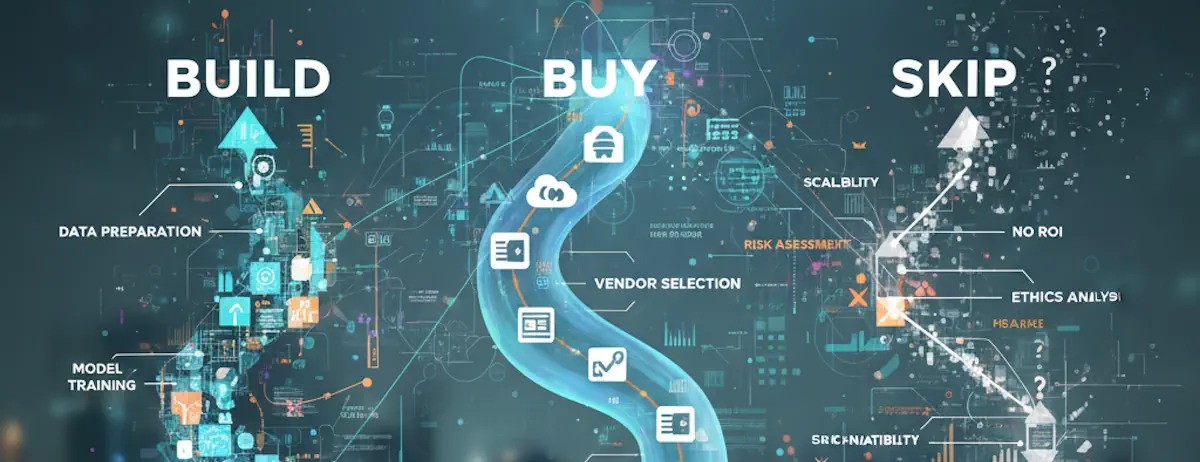You're Not Pushing Hard Enough
Why validated experiments might signal you're stuck in evolutionary mode when revolution is needed

I watched a team celebrate their second month of “successful” experiments this week. Every test validated their hypotheses. Every A/B result met expectations. No lessons learned because everything worked “perfect.”
The real lesson is that if all your experiments simply validate your assumptions, you’re probably not asking the right questions or pushing boundaries hard enough for revolutionary change. You’re making evolutionary improvements while someone else is rewriting the rules.
The Validation Trap
Evolutionary products are meaningful improvements and modifications that create steady progression, allowing adjustments to market demands, competition and technological advancements. These improvements are safer, less expensive, and fit existing distribution channels perfectly.
But they have a hidden cost–they keep you operating within known boundaries.
If your innovation improves an existing product 10%, it is evolutionary. If your innovation is a 10x improvement, and especially if it creates a new market, it is revolutionary. Revolutionary innovation rarely happens in risk-averse environments where every hypothesis must be validated before proceeding.
The teams making revolutionary breakthroughs aren’t celebrating perfect validation rates. They’re learning from failures that teach them something genuinely new about user needs, market opportunities, or technical possibilities.
Revolutionary vs. Evolutionary Indicators
• Frequent surprises and pivots
• Users can't describe their needs
• Creating new behaviors
• Separate innovation teams
• Predictable improvements
• Clear customer feedback
• Optimizing existing flows
• Integrated with operations
When Revolutionary Becomes Essential
Three signals tell me a team needs to shift from evolutionary to revolutionary thinking:
Market stagnation despite optimization. You’re hitting diminishing returns on incremental improvements. Incremental provides advantages until one specific level, where the improvement starts to be lower in each cycle. That’s when revolutionary approach provides the necessary leap.
Disruptive competitors gaining ground. When startups are capturing market share with solutions that seem “worse” by traditional metrics, they’re often serving unmet needs or creating new value propositions your evolutionary improvements can’t address.
Customer behavior shifting fundamentally. The jobs customers are trying to get done are changing, but your product evolution is still optimizing for yesterday’s workflows.
Kodak exemplifies this trap perfectly. Kodak engineer Steve Sasson invented the digital camera in 1975. However, management refused to introduce it because it would cannibalize its enormous photographic film and processing business. They had the revolutionary technology but chose evolutionary improvements to their existing business model instead.
“The reason why it is so difficult for existing firms to capitalize on disruptive innovations is that their processes and their business model that make them good at the existing business actually make them bad at competing for the disruption.”
— Clayton M. Christensen
The Courage to Break Your Own Success Formula
Revolutionary innovation requires doing things that feel wrong based on current success metrics. You need to be willing to:
Accept higher failure rates. The breakthrough innovations come when the tension is greatest and the resources are most limited. That’s when people are actually a lot more open to rethinking the fundamental way they do business.
Invest in seemingly inferior solutions. Revolutionary products often start worse than existing solutions in traditional metrics while being better in new ways customers didn’t know they needed.
Separate innovation from operations. Companies, in fact, are specifically organized to under-invest in disruptive innovations! This is one reason why we often suggest that companies set up separate teams or groups to commercialize disruptive innovations.
Rallying Teams Around Revolutionary Change
Moving from evolutionary to revolutionary requires different leadership approaches. Teams comfortable with predictable improvement cycles resist the uncertainty revolutionary innovation demands.
Start with the why, not the what. Don’t lead with the solution—lead with the problem that evolutionary approaches can’t solve. Show the data on diminishing returns, competitive threats, or shifting customer needs.
Create psychological safety for “intelligent failures.” Distinguish between preventable failures (poor execution) and intelligent failures (testing new hypotheses in uncertain territory). Celebrate learning from the latter.
Use separate metrics and timelines. Revolutionary initiatives need different success criteria than operational improvements. Revolutionary innovation (speed or first to market concepts) is only optimal under the following conditions: high performance products, long product lifecycles, a relatively long window of market opportunity, relatively high sales, stable margins, and relatively flat development costs.
Build bridges to existing operations. Even revolutionary projects need evolutionary thinking for refinement and scaling. The fact remains that the two approaches actually rest on each other. Revolutionary innovation creates new possibilities; evolutionary improvement makes them practical.
Revolutionary Change Management Framework
The Apple Paradox
Apple does a great job demonstrating how revolutionary and evolutionary innovation work together. The iPhone wasn’t the first smartphone and the iPad wasn’t the first tablet. Apple ENHANCES. Apple EVOLVES ideas. But this misses the deeper pattern.
Apple’s breakthroughs—Mac, iPhone, iPad—were revolutionary in user experience even while building on existing technologies. Then they spent years making evolutionary improvements to these revolutionary platforms.
The key insight: Apple didn’t stop there. It further evolved these groundbreaking innovations into a suite of related products, enhancing and expanding their initial offerings. Revolutionary innovation creates the platform; evolutionary innovation captures the value.
When to Choose Revolution
Not every product needs revolutionary thinking. Here’s when revolutionary approaches become essential:
When incremental improvements hit diminishing returns. Your optimization efforts yield smaller gains each cycle.
When competitive advantage erodes despite best practices. You’re doing everything right according to conventional wisdom but losing ground.
When customer needs shift fundamentally. The jobs customers need done are changing faster than your product can evolve.
When new technologies enable entirely new approaches. Revolutionary innovations often combine existing technologies in new ways that create step-function improvements.
Making the Choice
The decision between evolutionary and revolutionary approaches shouldn’t be philosophical—it should be strategic. Ask these questions:
- Are we hitting diminishing returns on improvements?
- Do our experiments consistently validate expectations?
- Are disruptive competitors gaining ground with “inferior” solutions?
- Have customer needs shifted beyond our current product paradigm?
If you answer yes to multiple questions, your team might need to embrace more failure, uncertainty, and revolutionary thinking.
Most organizations need both approaches, but at different times and for different purposes. The key is recognizing when each approach serves your strategic goals.
Here’s my challenge: Look at your last ten experiments. If more than eight validated your hypotheses, you might not be pushing hard enough. Revolutionary breakthroughs require the courage to test ideas that might fail—and to learn something genuinely new when they do.








